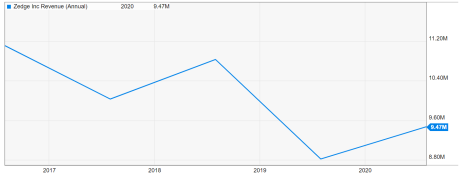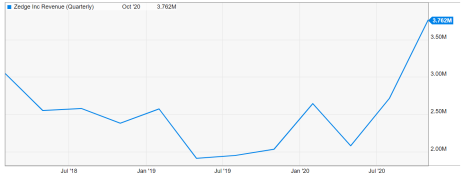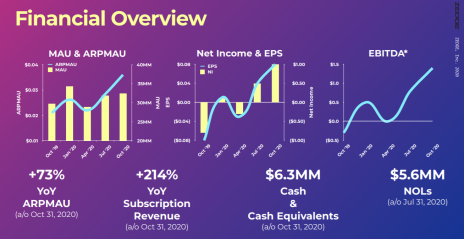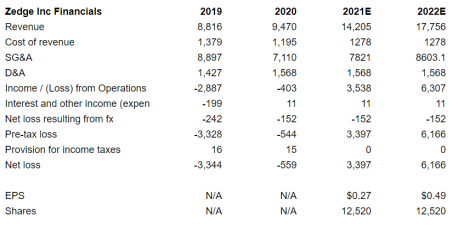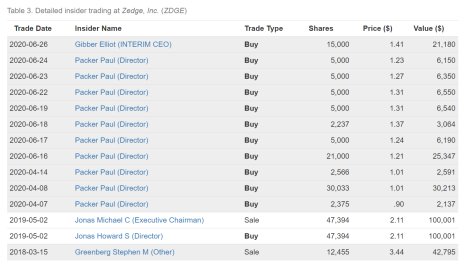Today, we are recommending a leading app developer.
The stock is near a 52 week high, but I think there is ~50% additional upside over the next year.
This company’s characteristics include:
•85% revenue growing in its most recent quarter
•A reasonable valuation (P/E of 19x annualized earnings)
•Company insiders own over 12% of shares outstanding
•Recent insider buying
All the details are inside this month’s Issue. Enjoy!
Cabot Micro-Cap Insider 121
[premium_html_toc post_id="223481"]
How I Pick Micro-Caps
It’s been a while since I’ve explained my process for picking micro-cap stocks so I figured it would be worthwhile to review.
It can be extremely profitable to invest in growth companies, as any Tesla or Amazon shareholder will tell you.
But it is also easy to get burned when growth slows, especially if the stock is trading at a nosebleed valuation. In the micro-cap world, you can invest in growth companies at value prices. And the data suggests that it can be very profitable.
O’Shaunnessy Asset Management found that the smallest, cheapest stocks generated an average annual return of 28.2% from 1982-2016, trouncing the market by a wide margin.
The next important thing to focus on is momentum, both in the operations of the business as well as the stock price. If you invest in a cheap stock with weak operational trends and a downward sloping stock chart, odds are it will be a value trap.
From 1982-2016, high-momentum micro-cap stocks generated average annual returns of 23.9%. Don’t be afraid to buy a stock at an all-time high!
The final factor to look into is liquidity. Generally, the more illiquid the stock, the better it will perform. Over the same 1982-2016 time period, the most illiquid micro-cap stocks generated an average return of 18.4%.
If you think you have found an attractive micro-cap stock but it has 100 million shares outstanding or even worse, a billion shares outstanding, odds are it won’t be a profitable investment.
Our new investment recommendation this week checks all of these boxes. It’s growing rapidly yet trades at a cheap valuation. Further, it has momentum (near 52-week highs) and is illiquid.
Also, this week our monthly webinar will take place on Thursday, January 14 at 2 p.m. ET. We will review all open recommendations and answer subscriber questions. Feel free to email questions to me ahead of time at rich@cabotwealth.com and I can answer them during the webinar.
Now let’s get into my newest recommendation: Zedge Inc (ZDGE).
New Recommendation
Zedge: An 85% Grower Trading at 19x Annualized Earnings
Company: Zedge Inc.
Ticker: ZDGE
Price: 6.01
Market Cap: $75 million
Enterprise Value: $67 million
Price Target: 9.80
Upside: 63%
Recommendation: Buy Under 6.50
Recommendation Type: Rocket
Executive Summary
Zedge (ZDGE) is a leading app developer that is currently growing revenue at 85% yet trades at only 19x earnings. The wealthy Jonas family, whose patriarch is IDT founder Howard Jonas, which spun off Zedge among others, owns ~11% of shares outstanding, ensuring high shareholder alignment. The management team has turned around the business and growth is expected to stay strong for the foreseeable future. Even though the stock is near a 52-week high, it is still undervalued. I see 50%+ upside over the next year.
Zedge Overview
Zedge was a 2016 spin-off from IDT Corporation (IDT).
The company is a leading app developer focusing on the mobile phone personalization and entertainment verticals. Specifically, the app allows users to customize their phones’ wallpaper and ringtones.
What exactly is phone wallpaper? It is the background to your phone’s main screen. See an example below.
Amazingly, 465 million people have downloaded the Zedge app to help customize their wallpaper and ringtones and 32 million people use the app every month.
Ninety percent of its users are on the Android platform, which is easier to customize, while 10% of users are on the iOS (Apple) platform.
At the time of the spin-off in 2016, the company generated all its revenue from advertising (it gave its wallpaper and ringtones away for free).
From 2016 through 2019, the company lost monthly active users in developed markets and gained users in developing markets.
As advertising rates are lower in developing markets, it resulted in lower revenue during the period, as shown below.
However, the company launched Zedge Paid Subscriptions in 2019, and that has been a smashing success.
Customers who sign up for a Zedge Paid Subscription get to access all of Zedge’s content without any advertisements. Google retains 30% of the fee charged for the initial subscription and 15% of any annual renewal fees.
In the most recent quarter, the number of paid subscribers increased by 205% and subscription revenue increased by 214%. As a result, revenue grew 85% to $3.8MM.
The sharp turnaround in revenue can be seen below.
In addition, Zedge has a number of additional initiatives such as Zedge Shortz, a short-form, chat fiction app, and the continued maturation of Zedge Premium, a marketplace for artists to sell their digital content.
Before we dive into Zedge’s business outlook, the below graph gives a nice overview of important milestones in Zedge’s history.
Business Outlook
As discussed above, momentum in Zedge’s business is extremely strong as revenue grew 85% in the most recent quarter.
The graphic below shows how all key indicators are showing promising trends.
Management has guided to “at least” 20% growth in 2021. Given 85% growth in Q1, I view this guidance as laughably conservative.
Next quarter is the company’s seasonally strongest and the subsequent quarter should be quite strong as well.
As a result, I’m expecting revenue growth of 50% for 2021. To be conservative, I assume revenue growth moderates to 25% in 2022. My assumptions yield earnings per share estimates of $0.27 and $0.49 in 2021 and 2022, respectively.
Importantly, my projections do not factor in any growth from Zedge Shortz or any other future products that Zedge launches. The management team expects to launch several new products each year.
Insider Ownership and Insider Buying
One important factor (especially with micro-caps) to consider is insider ownership.
As I mentioned before, the Jonas family owns ~11% of the company, ensuring we are aligned as shareholders
Further, there has been significant insider buying recently (albeit at lower prices).
Strong Balance Sheet
Zedge has a very strong balance sheet with no debt and $6MM of cash on its books. Further, the company will generate positive free cash flow every quarter going forward.
Valuation and Price Target
While Zedge is not dirt cheap on an absolute basis, it is very cheap if you factor in its growth.
Zedge generated $0.08 in earnings in the first fiscal quarter of this year, or $0.32 annualized. As such, the stock is trading at 19x annualized earnings. This is a very cheap multiple for a company that is growing revenue at 85%.
Given that I expect earnings to grow 25% per year in 2022 and beyond, I believe a 20x earnings (P/E) multiple is appropriate. Applying a 20x earnings multiple to my 2022 earnings estimate of $0.49 implies a fair value of $9.80.
On average, companies in the software industry trade at a P/E multiple of 67x, but I think a 20x multiple is more appropriate for Zedge given it is a micro-cap and has a higher risk profile.
As always with micro-caps, remember to use limits when buying Zedge as the stock is illiquid. Buy under 6.50.
Risks
- It’s Dependent on Google Play and Apple App Store for Downloads.
- While Zedge is reliant on Google Play and, to a lesser extent, the Apple App Store, the company has historically done a good job of staying compliant. Nonetheless, suspension of the Zedge app would have a serious negative impact on revenue generation.
Recommendation Updates
Changes This Week
No changes.
Updates
BBX Capital (BBXIA) recently filed an 8-k, which disclosed that Angelo Gordon owns 4.9% of the company and that BBX Capital had granted Gordon permission to buy up to 10% of the company. I view this as bullish given: 1) Angelo Gordon is a sophisticated investor and sees significant value, and 2) management was open to taking on outside investment. I recently spent considerable time reviewing my investment thesis for BBX Capital. All in all, the investment case remains on track. Despite strong performance, the company trades at just 30% of book value. It should generate significant earnings and free cash flow in 2021. In October 2020, the company announced that it had authorized a $10 million share repurchase, representing 10% of its market cap. The company also recently announced that it has purchased Colonial Elegance, a supplier and distributor of building products, including barn doors, closet doors, and stair parts for 5.6x EBITDA, an attractive price. Despite poor historical corporate governance, we are aligned with management as the Levin family (controlling shareholders) own 42% of shares outstanding. I see 50%+ upside. Buy under 5.00.
Donnelley Financial Solutions (DFIN) had a quiet week with no news. Donnelley Financial Solutions (DFin) is a 2016 spin-off that has successfully executed a turnaround, transitioning from a mainly print-focused business to a software/tech-enabled services business. Despite strong cash flow generation and debt paydown, the stock still trades at a draconian valuation. Simcoe Capital, an activist investor, owns 10% of the stock, ensuring we are well aligned with insiders. With modest earnings growth and multiple expansion, coupled with significant debt paydown, the stock should hit 40 by 2024, implying over 100% upside. Buy under 19.00.
Dorchester Minerals LP (DMLP) reported recent insider buying as the CFO purchased about $18,000 of stock in the open market at an average price of $10.92. While this purchase isn’t massive, it is nonetheless bullish. Back in November, the company reported Q3 earnings. There were no surprises. Through September, the company had generated $32MM of free cash flow, or $43MM on an annualized basis. As such, it is trading at 9.3x annualized free cash flow. This is an incredibly cheap valuation for a debt-free royalty business that pays out all its income in dividends and will skyrocket if (when) energy markets recover. The last distribution of $0.33 was paid on November 12. This yield on an annualized basis works out to a yield of 11.4%. Buy under 12.00.
FlexShopper (FPAY) was up this week on no news. Last week the president and co-founder Brad Bernstein resigned. This was not too surprising. Last year, the board had voted to bring in a new CEO (Richard House), and typically founders don’t stick around for too long after a new CEO is hired. In my mind, this is a non-issue. I continue to like the stock. It is a rapidly growing company in the virtual lease-to-own market. Despite rapid growth and margin expansion, it is only trading at 9.7x 2021 earnings. Importantly, the chairman of FlexShopper owns over 20% of the company and has been buying more stock as fast as he can in the open market. Recently, H.C. Wainwright published an initiation report on the company with a $4.00 target. Also, I recently had a chance to talk to management (both the CEO and CFO), and it increased my conviction in the idea. I see 100%+ upside over the next year. Buy under 2.50.
Greystone Logistics (GLGI) had another quiet week. The company reported first-quarter fiscal 2021 earnings in October. In the quarter, sales declined by 6%. There was a ~16% increase in volume, but pricing structure and product mix drove the sales decline. Importantly, gross margin increased from 12.6% to 16.8%. This drastic gross margin expansion drove a 25% increase in gross profit despite the sales decline. The strong gross profit growth coupled with lower interest expenses and preferred dividends drove 94.5% EPS growth. I’m conservatively estimating forward earnings of $0.13 in fiscal 2021. As such, the stock is trading at 7.3x forward earnings. This is too cheap for a company that has historically grown revenue at a four-year CAGR of 30.4%. Further, after the 10-Q was filed we saw significant insider buying from CEO and President Warren Kruger and a director. In total, Kruger owns over 30% of the company. As such, we are well aligned as we will benefit from both continued strong operational performance and stock price increases. Buy under 1.10.
HopTo Inc (HPTO) had no news this week, but the stock has generally been weak since reporting earnings in November. In the quarter, sales declined by 6%. However, just as we didn’t get too excited last quarter when sales jumped 49%, we aren’t going to get too down this quarter. On a quarterly basis, sales are lumpy. Year to date, revenue is up 3% and operating profit is up 5%. The stock has pulled back and looks attractive. I believe HPTO is worth ~$0.86 per share. HopTo is currently trading at an EV/EBIT multiple of 6.6x. This is too cheap. To put it in perspective, the software and internet industry trades at an average EV/EBIT multiple of more than 50x. Buy under 0.55.
Liberated Syndication (LSYN) was quiet this week. Over the past couple of months there has been significant insider buying from the CEO, CFO, and directors including activist investor Eric Shahinian of Camac Partners. Camac Partners currently owns 7.9% of shares outstanding, ensuring strong alignment. Libsyn recently reported earnings. As expected, the quarter was a little messy due to compensation expenses related to the former CEO, Chris Spencer, leaving. Nonetheless, the long-term outlook looks great. Another interesting thing to monitor is that Libsyn recently filed an 8-k disclosing that it is suing several of its largest shareholders to force them to forfeit their shares. The backstory is a little complicated but here is a good article that summarizes it. The key takeaway is it would be a huge positive for us if Libsyn wins its lawsuit as shares outstanding would drop from 26.6MM to 19.4MM, a 27% decline. Buy under 4.25.
MamaMancini’s Holdings (MMMB) reported earnings in early December. Revenue grew 6.8% while EPS grew 100% to $0.02 as the company continues to leverage its fixed cost base. Sales growth decelerated slightly due to COVID headwinds, but I’m confident sales will reaccelerate in 2021 and beyond. Additionally, the company is currently running a strategic review, which could result in the company being sold. Whether or not the company is sold, I believe returns should be strong going forward given the company will continue to grow and generate strong earnings growth. It has historically grown revenue at a 24% CAGR clip yet only trades at 10x forward earnings. Management owns over 50% of the stock, ensuring that incentives are aligned. Further, the company has a clean balance sheet. Buy under 2.00.
Medexus Pharma (MEDXF) reported earnings in November. Medexus generated revenue of $23.6MM, which was up 44% y/y but down 14% sequentially. The reason for the decline was ~$3MM of IXINITY (hemophilia drug) sales slipped from September to October. As such, I expect next quarter to be unusually strong. Year to date, Medexus has generated $4MM of free cash flow, or $8MM annualized. As such, the stock is trading at 12x free cash flow, an incredibly cheap valuation for a rapidly growing company. On an EV/Revenue basis, MEDXF trades at 1.1x while slower growing peers trade at 3.6x. Medexus recently gave a great presentation, which is available on YouTube. Medexus remains my highest conviction idea. Buy under 5.50.
NamSys Inc. (NMYSF) recently reported fiscal Q3 earnings (quarter ended July 31). Revenue grew 11.8%, which is impressive given pandemic-related headwinds. Gross margins were under pressure due to an accrual of management bonuses as well as increased staffing related costs. I’m not concerned with the management bonus as it is based on continued strong execution. The increased staffing costs relate to the high demand and required salary for software engineers/programmers. I will monitor this going forward. The most important factor for NamSys is continued revenue growth. Despite historically growing revenue and earnings at a compound annual growth rate of 20%+, the stock only trades at 22x 2019 earnings. It has a pristine balance sheet with significant cash and no debt, and insiders own over 40% of the company, ensuring strong alignment. Buy under 0.80.
P10 Holdings (PIOE) recently closed its acquisition of Enhanced Capital Group, a premier impact investment platform. Since its inception, Enhanced has deployed over $2BN of capital into impact credit and impact equity investments. Areas of focus include small business lending in impact areas and to women and minority-owned businesses, renewable energy, and historic building rehabilitation. My estimate is that this transaction will increase run rate EBITDA to ~$75MM. As such, P10 is trading at an EV/EBITDA multiple of 14.0x. As I have said before, the stock is no longer dirt cheap. Nonetheless, it still trades at a sharp discount to its closest peer, Hamilton Lane (HLNE), which trades at an EV/forward EBITDA multiple of 30.4x. Catalysts for P10 Holdings going forward include: 1) additional deals and 2) a potential up-listing to a major exchange. Given the stock is not dirt cheap anymore, I recommend holding a half position. I want to keep exposure to the name but think it’s prudent to book some profits. Hold Half.
U.S. Neurological Holdings (USNU) reported earnings in November. Revenue grew 0.6% y/y and 11% q/q as procedures and price per procedure both rebounded. Year to date, the company has generated EPS of $0.05, or $0.067 on an annualized basis. As such the company is trading at just 3.9x earnings. In addition, the company has $1.5MM ($0.19 per share) of cash and no debt on its balance sheet. It also has $1.1MM (due from related parties) and has generated over $500,000 in free cash flow year to date. U.S. Neurological Holdings operates as a holding company in the United States. It is engaged in providing medical treatment and diagnostic services that include stereotactic radiosurgery centers, utilizing gamma knife technology, and it holds interests in radiological treatment facilities. Buy under 0.25.
Watch List
FitLife Brands (FTLF) sells nutritional products for health-conscious consumers. It has been growing quickly and trades at 5x earnings. The one area of concern is that 75% of sales go to GNC, which recently declared bankruptcy. Nonetheless, FitLife somehow has been able to grow sales slightly in 2020. This is a name that I will continue to track.
Waitr Holdings (WTRH) has been on my watch list for a while now, but I haven’t had the conviction to pull the trigger. Waitr recently announced Q3 earnings and revenue declined by about 20% from Q2. However, there has been some buying by two insiders, which bodes well.
Recommendation RATINGS
| Stock | Price Bought | Date Bought | Price 1/12/20 | Profit | Rating |
| BBX Capital (BBXIA) | 3.17 | 10/5/20 | 5.50 | 74% | Buy under 5.00 |
| Donnelly Financial Solutions (DFIN) | 14.54 | 11/11/20 | 18.34 | 26% | Buy under 19.00 |
| Dorchester Minerals LP (DMLP) | 10.49 | 10/14/20 | 12.91 | 26% | Buy under 12.00 |
| FlexShopper (FPAY) | 2.13 | 12/9/20 | 3.09 | 45% | Buy under 2.50 |
| Greystone Logistics (GLGI) | 0.81 | 7/8/20 | 0.95 | 17% | Buy under 1.10 |
| Hopto Inc (HPTO) | 0.39 | 4/28/20 | 0.46 | 18% | Buy under 0.55 |
| Liberated Syndication (LSYN) | 3.06 | 6/10/20 | 4.88 | 59% | Buy under 4.25 |
| MamaMancini’s Holding (MMMB) | 1.76 | 8/12/20 | 2.01 | 14% | Buy under 2.00 |
| Medexus Pharma (MEDXF) | 1.78 | 5/13/20 | 5.45 | 206% | Buy under 5.50 |
| NamSys Inc (NMYSF) | 0.65 | 9/9/20 | 0.85 | 31% | Buy under 0.80 |
| P10 Holdings (PIOE) | 1.98 | 4/28/20 | 6.10 | 208% | Hold Half |
| U.S. Neurological Holdings (USNU) | 0.14 | 4/28/20 | 0.27 | 93% | Buy under 0.25 |
| Zedge (ZDGE) | 6.01 | 1/13/21 | 6.01 | 0% | Buy under 6.50 |
*Includes 0.75 distribution and 1.35 distribution.
Glossary
Buy means accumulate shares at or around the current price.
Hold means just that; hold what you have. Don’t buy, or sell, shares.
Sell means the original reasons for buying the stock no longer apply, and I recommend exiting the position.
Sell a Half means it’s time to take partial profits. Sell half (or whatever portion feels right to you) to lock in a gain, and hold on to the rest until another ratings change is issued.
Disclosure: Rich Howe owns shares in BBXIA, HPTO, PIOE, MEDXF, LSYN, GLGI, and FPAY. Rich will only buy shares after he has shared his recommendation with Cabot Micro-Cap Insider members and will follow his rating guidelines.
The next Cabot Micro-Cap Insider issue will be published on February 10, 2021.
Cabot Wealth Network
Publishing independent investment advice since 1970.
President & CEO: Ed Coburn
Chairman & Chief Investment Strategist: Timothy Lutts
176 North Street, PO Box 2049, Salem, MA 01970 USA
800-326-8826 | support@cabotwealth.com | CabotWealth.com
Copyright © 2021. All rights reserved. Copying or electronic transmission of this information is a violation of copyright law. For the protection of our subscribers, copyright violations will result in immediate termination of all subscriptions without refund. No Conflicts: Cabot Wealth Network exists to serve you, our readers. We derive 100% of our revenue, or close to it, from selling subscriptions to its publications. Neither Cabot Wealth Network nor our employees are compensated in any way by the companies whose stocks we recommend or providers of associated financial services. Disclaimer: Sources of information are believed to be reliable but they are not guaranteed to be complete or error-free. Recommendations, opinions or suggestions are given with the understanding that subscribers acting on information assume all risks involved. Buy/Sell Recommendations: All recommendations are made in regular issues or email alerts or updates and posted on the private subscriber web page. Performance: The performance of this portfolio is determined using the midpoint of the high and low on the day following the recommendation. Cabot’s policy is to sell any stock that shows a loss of 20% in a bull market or 15% in a bear market from the original purchase price, calculated using the current closing price. Subscribers should apply loss limits based on their own personal purchase prices.

